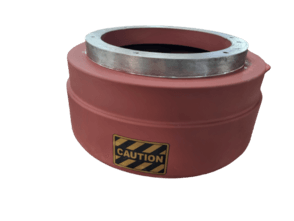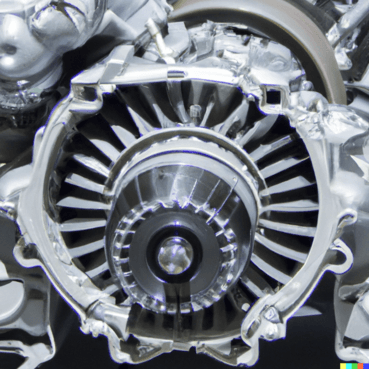Engine Mounted Alternator
To understand Innotec’s Flywheel Alternators and DC Generators, you need to understand the basics of engine flywheels and bell housings. The below will serve as a primer for the engine mounted alternators.
Industrial Engine Generators

A flywheel is a large, heavy disk that is connected to the crankshaft of an engine. Its main function is to store rotational energy, which helps to keep the engine running smoothly and maintain a consistent speed, even when there are fluctuations in the load on the engine. The flywheel also helps to smooth out the power output of the engine, making it more consistent and reliable.
A bell housing is a cylindrical enclosure that surrounds the flywheel. It also aligns and support the engine and the attaching alternator or transmission.
Together, the flywheel and bell housing are critical components of an industrial engine, helping to ensure that the engine runs smoothly and efficiently and that it is able to deliver consistent, reliable power output.
SAE Standards
SAE (Society of Automotive Engineers) flywheel and bell housing sizes for engines are standardized measurements used to ensure compatibility between engines and transmissions.
Flywheels are classified by SAE according to their diameter and the number of mounting holes they have. SAE flywheel sizes for engines typically range from SAE No. 0 (the smallest size) to SAE No. 4 (the largest size). Within each size, there are also variations in the number of holes used for mounting the flywheel to the crankshaft.
Bell housing sizes for engines are also classified by SAE, and are identified by a number and letter code. The number in the code indicates the size of the bell housing, and the letter indicates the type of transmission that the bell housing is designed to be used with.
It is important to note that these are industry standards and some manufacturers may have their own proprietary measurements and classifications. It is also important to check the compatibility between the engine and the transmission when using different flywheel and bell housing sizes. For this reason, Innotec asks for confirmation of an engine drawing for new customer inquiries. This protects both parties to make sure we get the right fitting generator head for the selected engine.
Engine Manufacturer Specific

For DC Alternator applications, It’s best to check with the manufacturer or the supplier of the engine for the most up-to-date information. They should be able to provide you with the correct size and specifications for your particular engine model. Some general information that could be helpful, it’s important to match the flywheel and bell housing size with the engine and transmission to ensure proper fit and function. Also, note that the size and configuration of the flywheel and bell housing can vary depending on the specific application and the intended use of the engine.
Flywheel Mounting for the Engine Mounted Alternator
The PCD (Pilot Circle Diameter) of an engine’s bell housing is the diameter of the circle that is formed by the center points of the bolts that are used to attach the bell housing to the engine. It is a critical measurement that is used to ensure that the bell housing is compatible with the engine.
The PCD is typically measured in millimetres and is usually specified by the manufacturer of the engine. It is important to note that the PCD of the bell housing should match the PCD of the engine, otherwise, the bell housing will not fit properly. It is recommended to consult the manufacturer’s documentation or consult with the supplier of the engine for the most accurate and up-to-date information about the PCD of the bell housing for a specific engine model.
If possible send us the drawings of the engines to review and can help configure the right model for the right engine.
We have worked with most common industrial engines to configure the right engine mounted alternator but it is always a good idea to get an updated model or drawing from the distributor when possible.
Send an email to discuss more.
